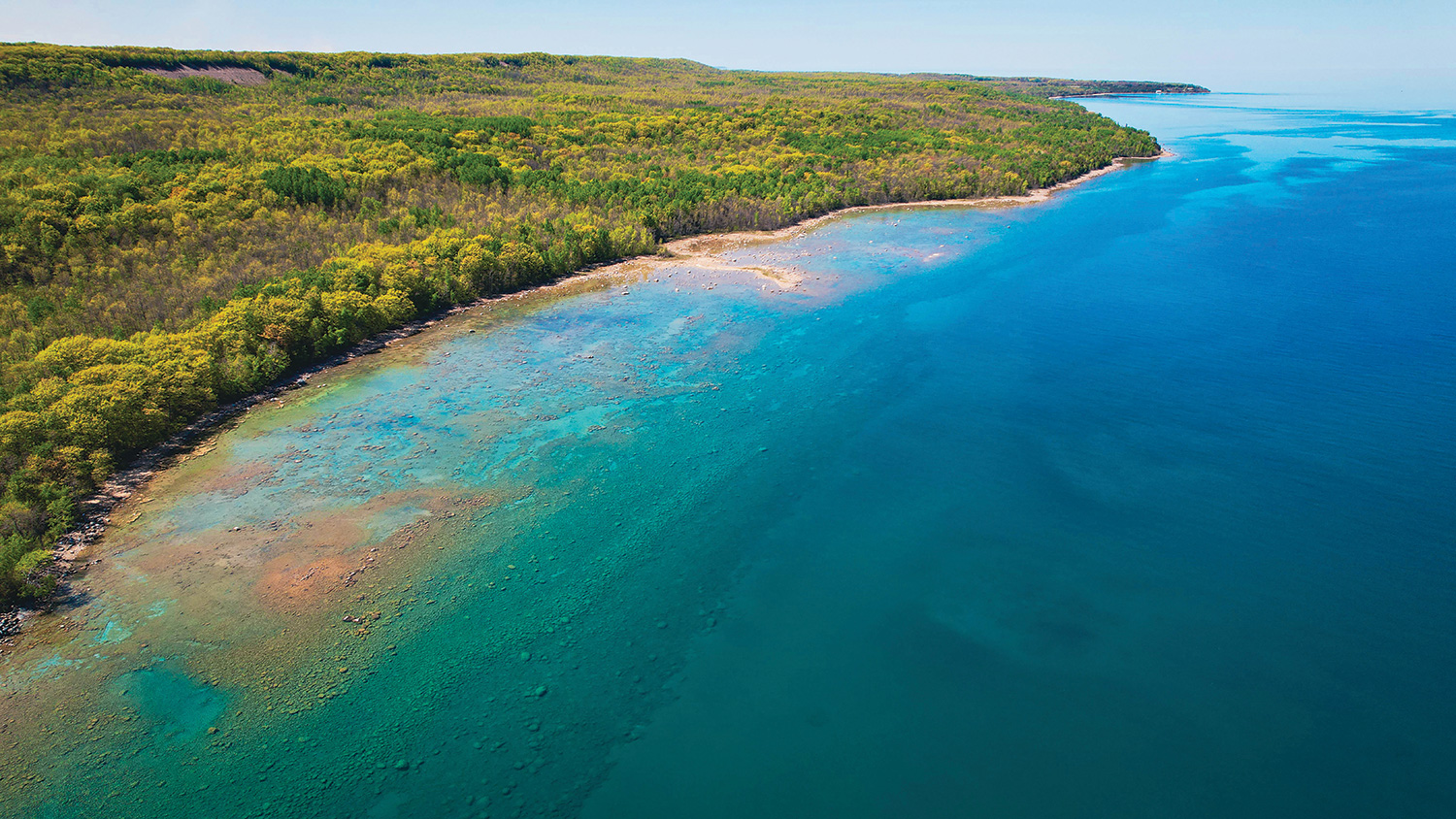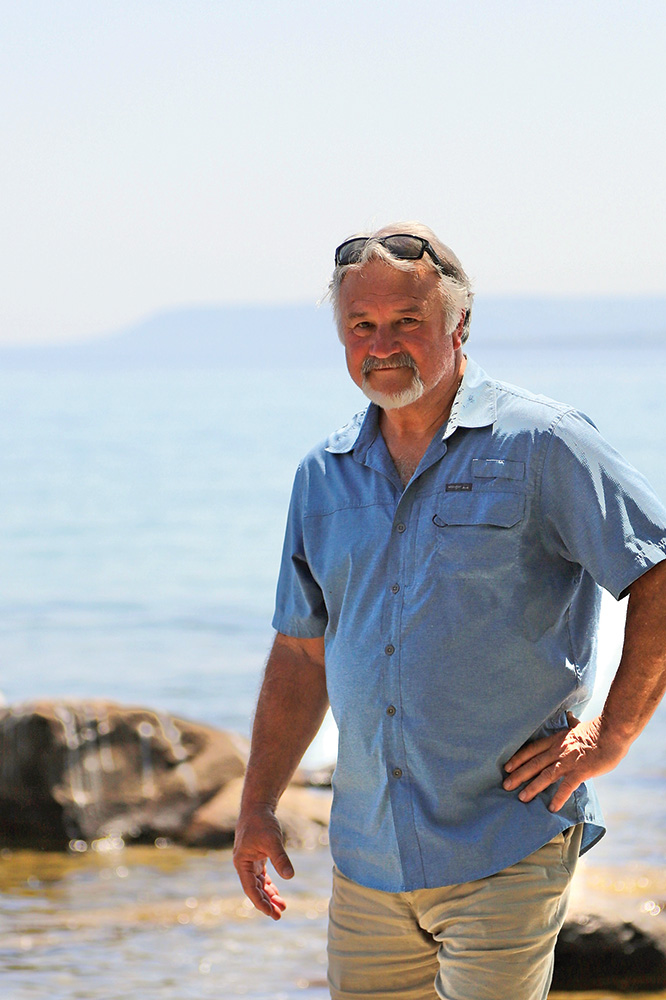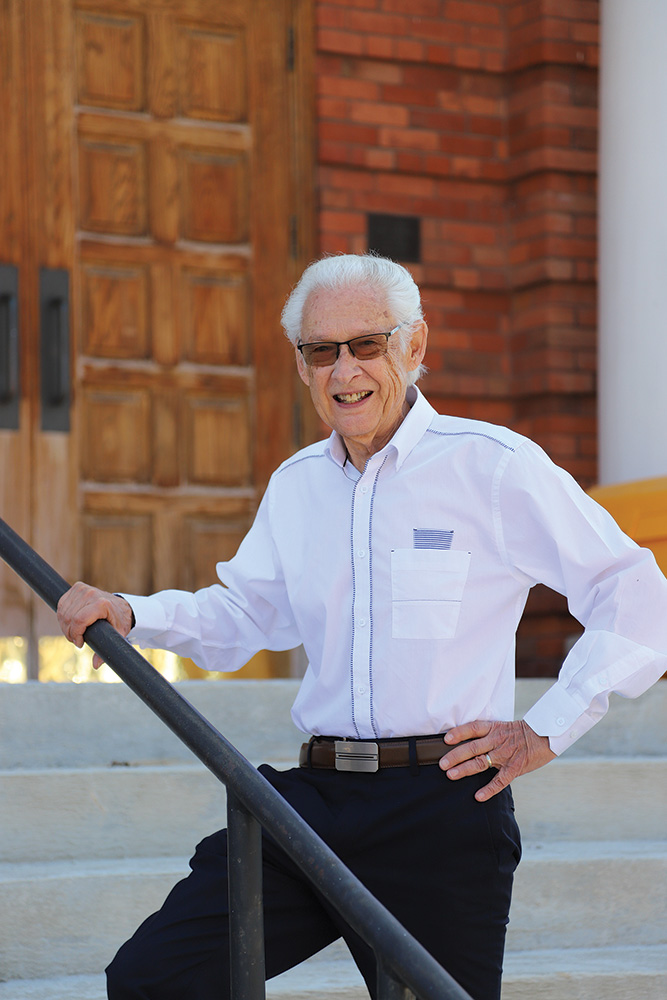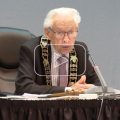Inside TC Energy’s plan for a pumped storage facility in Meaford.
By Roger Klein // Photography by Roger Klein

Officially, TC Energy’s electricity-storing megaproject—proposed for the 4th Canadian Division Training Centre on Department of National Defence (DND) land in Meaford—is called the Ontario Pumped Storage Project. TC Energy (TCE) promises the facility will reduce greenhouse gas emissions, create jobs and make Ontario’s electricity grid more efficient. Community groups, however, call it Ontario’s worst energy mistake and a threat to Georgian Bay.
Pumped storage works like a large-scale battery, utilizing water and gravity to store energy. TCE is proposing the construction of a 152-hectare reservoir to hold millions of cubic metres of water. During periods of low energy demand, water would be pumped upslope to the reservoir and held before being released back into Georgian Bay to regenerate electricity at times of peak demand.
The drawing and releasing of water would repeat every 24 hours. An underwater, high-voltage cable would run 40 kilometres across the lakebed to Wasaga Beach, where it would connect to the power grid via Hydro One’s Stayner transformer station. TCE predicts the system will be 75-percent efficient and will help lower the province’s greenhouse gas emissions by reducing the need for electricity generated from natural gas during periods of peak demand.
The Local Opposition
The public first learned about the pumped storage proposal in December 2019 when crowds of people filled the Meaford Community Centre for an open house meeting hosted by TCE.
At the time, Tom Buck and his neighbours along Cedar Avenue in Meaford were already aware of the plan; they had been approached by representatives from TCE several months earlier. Buck says an existing pumped storage facility in Ludington, Michigan, was used as an example of what was being planned for the Meaford project.
“So we started looking into what Ludington was like and we were horrified. We were horrified that it was killing millions of fish a year and the way it muddied up the water and we couldn’t conceive of that happening on this bay,” Buck recalls.
It didn’t take long before friends and neighbours started to organize against the proposal. The name of their association was the same as their call to action: Save Georgian Bay. Buck says their mission was to get the word out to neighbouring communities about the proposal.
“We started hosting information sessions about it, we’ve written articles and participated in articles about it. Our mission is to educate the region,” Buck says. Save Georgian Bay also collected more than 3,000 signatures on a petition to try and stop the project. “The Bay is a rare occurrence in our world today and why put that at risk? Why put that pristine bay at risk?” Buck questions.
Their ongoing concerns include the potential impact to fish and threatened or endangered species on land and water, impacts on water quality since many homes in the area use water directly from the Bay and the effects on land values and tourism.
Buck also points out the unusual circumstance that there are homes located below the proposed reservoir which could be catastrophically affected if the containment were to fail. “I asked TCE to identify anywhere else in North America where a project like this was going over the heads of 300 homes or about 1,000 people and they’ve never responded to that question,” Buck says.
“The Bay is a rare occurrence in our world today and why put that at risk? Why put that pristine bay at risk?”
Tom Buck, president,
Sunnyside Beach Cottage Association
The Land
Locally known as the Tank Range, the 4th Canadian Division Training Centre, or 4 CDTC, is a military training area in Meaford. It was created in 1942 when the DND expropriated and purchased the land from area farmers. The 80-square-kilometre property is adjacent to Bayview Escarpment Provincial Park and includes 22 kilometres of Georgian Bay shoreline. The landscape features escarpment cliffs, dense forest and rolling agricultural land, but is not included in the province’s Niagara Escarpment Plan since it is under federal jurisdiction. In July 2021, TCE reached an agreement with the DND to conduct feasibility studies for the construction of the pumped storage project.
The Company
First incorporated in 1951 as Trans Canada Pipelines, the company—which was later renamed TC Energy—was a 50/50 partnership between Canadian and American interests to build a natural gas pipeline from west to east on Canadian soil.
Over the past 70 years, TCE has grown to be an energy juggernaut with total assets of $119 billion. The company owns and controls one of North America’s largest natural gas storage and pipeline networks, which stretches more than 93,000 kilometres through Canada, the United States and Mexico. The company also owns and operates the Keystone Pipeline that connects oil producers in Western Canada to refineries in Texas. TCE is currently building the Coastal GasLink pipeline in British Columbia which will carry liquified natural gas through the Rocky Mountains to a terminal in Kitimat.
Electricity is another energy sector where TCE is heavily invested, owning interests in facilities that generate 4,300 megawatts of electricity, including 48 percent of Bruce Power which supplies Ontario with base load generation of over 50 terawatt hours annually or about one-third of Ontario’s electricity.
In theory, the pumped storage facility could supply up to four terawatt hours of stored electricity to the grid annually and offset about a third of the fossil fuel being used in the province’s energy mix, or 2.8 percent of the total energy output (2021).
According to TCE’s director of power development, John Mikkelsen, the facility would provide a service to the Ontario grid by responding quickly to shifts in demand, which in turn would reduce spikes in energy prices to the benefit of consumers. “It could store 11,000 megawatt hours—that’s a significant resource,” says Mikkleson.
Rather than monetize the stored energy in the open market, TCE plans to generate revenue based on a cost of service model that would be “rate regulated.” The pricing strategy would be overseen by the Ontario Energy Board and reviewed every four years. “It’s similar to the way we use our Ontario Hydro assets today. Those are legacy assets that are used to benefit the ratepayer, they are designed to maximize value for the ratepayer,” says Mikkelsen.
The Town and Community
Over the past four years, TCE has been busy justifying its grid-scale storage project to politicians, Ontario’s Independent Electricity System Operator (IESO) and the community at large.
The company has conducted several open house discussions, operated an information office in Meaford, established a community liaison committee, maintained an information website, sponsored local environmental initiatives (including the Great Lakes Plastic Cleanup), partnered with Georgian College to help identify local trades and human resources in the region and advertised in local media, including this magazine.
Feedback from the community has resulted in several design changes to the proposal, including locating the generating station deep underground and redesigning water intakes to help lower the velocity of water on the lakebed. The changes were made to help address concerns about noise and to mitigate fish entrapment and mortality at the intakes.
At a public meeting in February, Meaford’s town council decided in a 5-2 vote to provide their conditional support for the project despite passionate and vocal objections in a series
of deputations.
The town’s mayor, Ross Kentner, told On The Bay that he was opposed to the project when it was first proposed, but after seeing TCE’s willingness to modify its plans, he began to reconsider. He says legal advice indicated that the town could play more of a regulatory role with TCE operations and that would help guarantee some accountability as well as community benefits.
“We need a huge investment in the kind of amenities that will take Meaford into the future and really help it develop into the kind of community everybody wants. I can see that happening if this project goes ahead and we get the community benefits program that TCE would deliver,” Kentner explains.
The proposed community benefit agreement with the municipality would provide at least $1.5 million annually over the life of the project, according to TCE.
When asked for an update for area constituents, Rick Byers, the MPP for Bruce-Grey-Owen Sound, responded promptly, saying the province is reviewing TCE’s proposal. “I have spoken with Minister Smith and I know from those conversations that the Ministry of Energy, as well as the IESO, are conducting an analysis of the project to determine the value it could provide to ratepayers and what the next steps are,” Byers wrote in an email.
The company still needs to complete a provincial environmental assessment and federal impact assessment, two processes that will look at the environment, health, social and economic impacts as well as potential impacts on Indigenous and treaty rights. Currently, nothing related to the proposed project appears on the Canadian Impact Assessment Registry.

The Save Georgian Bay Association has already issued its own strategic environmental assessment report in response to the DND’s request for public comment. It addresses the various environmental concerns raised by the community. The report is backed by professional construction, hydroelectric and environmental engineers.
The Indigenous Community
The proposed project sits in the centre of the traditional territories of the Saugeen Ojibway Nation (SON), which includes two bands—the Saugeen First Nation and the Chippewas of Nawash Unceded First Nation.
According to the SON, its members’ traditional homeland includes the entire Bruce Peninsula and about 6,000 square kilometres south to Goderich and east to Collingwood. The SON is currently challenging the courts to recognize its Aboriginal title to the submerged lands of Georgian Bay and Lake Huron.
The SON is also making a treaty claim for ownership of any federally- or provincially-owned lands on the Bruce Peninsula not previously sold to third parties. An Ontario Superior Court recently decided that the Saugeen First Nation is the rightful owner of a 2.5-kilometre stretch of Sauble Beach.
Attempts were made to contact Indigenous leadership of SON and its respective bands, as well as the SON Environment Office and the Bagida’waad Alliance, an environmental organization of the Chippewas of Nawash. None expressed a willingness to communicate on the subject of the Ontario Pumped Storage Project. However, some First Nations community members’ online comments express a frustration with the engagement process. One comment on the Chippewas of Nawash Community Postings! Facebook group reads:
“I found out that there’s an agreement being drawn up with us, that I as a band member haven’t heard about or was informed. I know there’s meetings and we’ve had free meals, free gift cards, to get us to vote yes, just like NWMO is doing. One important meeting we had at Maadookii with TC Energy and at that meeting most people there didn’t want it and harsh words were spoken.
We asked questions too soon and too many. We asked for a referendum but none so far. So I want to know why?”


“The Ministry of Energy, as well as the IESO, are conducting an analysis of the project to determine the value it could provide to ratepayers.”
Rick Byers, MPP for Bruce-Grey-Owen Sound
Economic Benefits
With billions of dollars in play, the economics are hard to ignore. According to TCE’s economic impact study, the construction project would create more than 500 direct and indirect jobs. Operations would support another 20 full-time positions and flow money into the local economy through wages and the supply chains.
The same study found that there would be additional pressure on labour and housing markets. It would also increase demands on local infrastructure from water to roads and emergency services.
There may be job opportunities for the Indigenous community as well. In April 2022, TCE announced that an Indigenous construction company, Makawa-Cahill, had been selected to conduct a constructability and fabrication review of the inlet/outlet structure for the project.
“From the very beginning we talked about doing this as a partnership, doing this together in a collaborative manner,” says TCE’s John Mikkelsen. “It’s the most rewarding experience in my career, it’s the true meaning of reconciliation in my view.”
Members of the Labourers’ International Union of North America Ontario Provincial District Council have also expressed interest in the jobs that would be created.
Meanwhile, Tom Buck of Save Georgian Bay shakes his head at the whole idea of pumped storage and points to the IESO’s latest commitment to other grid-scale battery storage systems like the Oneida Energy Storage facility to be built in Jarvis, Ontario. Buck says the battery systems don’t have the environmental impact of pumped storage and are far more efficient.
“They are running at 90-percent efficiency plus. The cost differential is enormous. Ratepayers will want the utility bills associated with the Oneida-style projects, not this,” Buck concludes.
If approved, the construction of the Ontario Pumped Storage Project is expected to take about four years.
















